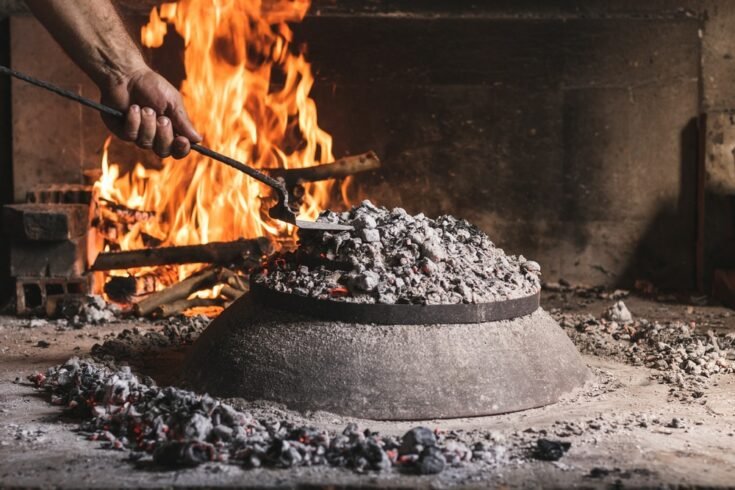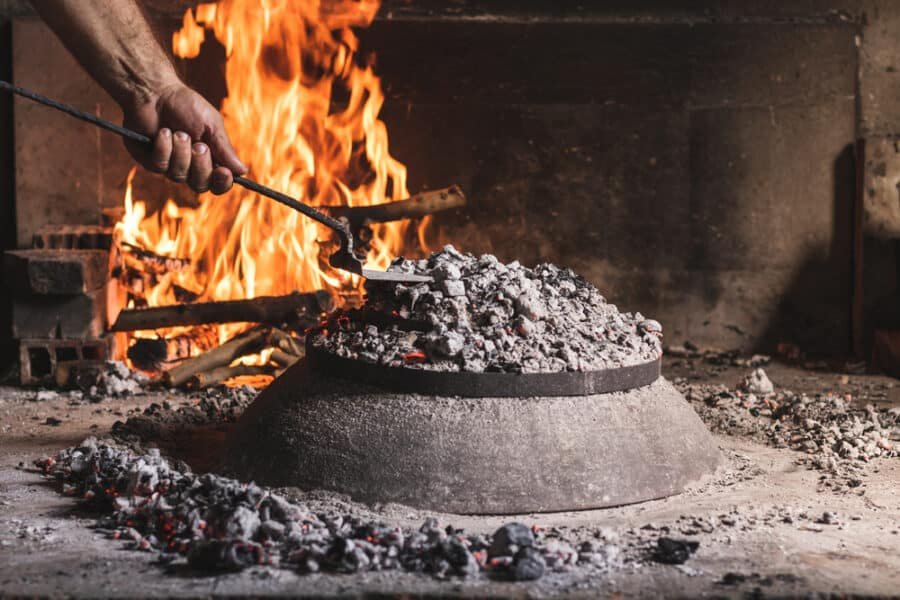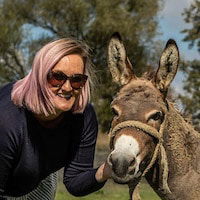Croatian cooking is at its very best with what is known as “under the lid.” Depending on which part of Croatia you live in, it is a literal translation of what we here in Croatia call “ispod čripnje” or “ispod peke”.
Ispod čripnje is essentially food cooked under extreme heat using a terracotta lid and burning wood embers. Ispod peke is our favorite way of cooking, which, along with grilled fish, requires very few ingredients and an open fire.
It is such a vital cooking method here in Croatia; we highly recommend trying your hand at it when visiting by taking this food & wine tour + cooking class near Zadar.

Under The Bell Recipe (Ispod čripnje/Peke)
Master Croatian cooking, with the dish known as ispod čripnje or ispod peke. This traditional style of cooking is explained in as easy to understand way.
Ingredients
- 2 kg Potatoes (4.4 lbs)
- Vegeta
- Extra Virgin Olive Oil (EVOO)
- Crushed garlic
- Vegetables - onions, carrots, peppers/paprikas
- Rosemary
- Bay Leaf
Options
- Seafood: Squid, cuttlefish or octopus.
- Meat: Veal, chicken, pork or lamb
- Vegetables - including a vegetarian option
- Plus: Bread
Instructions
Prepare
- Start your fire approximately one hour before you wish to start cooking. There are two important things to do here. In a large bowl, mix 2 kg of peeled potatoes, which have been cut into quarters lengthways. Season with Vegeta & good quality Extra Virgin Olive Oil (EVOO)
- Ensure you hang the čripnje lid/bell over the fire so it will heat up
- Make the fire in the same spot you will place the tray of meat and potatoes. The concrete below needs to be heated up as well
- Layer the potatoes, in a wide, yet shallow metal pan
- Season your meat with Vegeta, and coat with more EVOO and crushed garlic
- Place the meat on top of the potatoes
- You can also arrange around the meat, seasonal vegetables, such as onions, carrots, peppers/paprikas cut into quarters
- Throw in a few sprigs of rosemary and a bay leaf
Fire it up
- Place your metal pan in the cooking area, and cover with the lid/bell
- Cover the lid/bell with your wood embers, this will create a seal
- Leave it to cook. It's usually at this point a glass of domace rakija {home made brandy} is enjoyed
Skip Ahead To My Advice Here!
What Can You Cook Under Your Bell

Just like with lots of things in Croatian cooking, you eat what is in season.
This means any number of mouthwatering meals can be prepared using this method.
Favorites of ours here in the Adriatic are:
- Seafood: squid, cuttlefish, or octopus
- Meat: veal, chicken, pork & lamb
- Vegetables: here, you’ll find a vegetarian peka recipe
- Plus: bread
No matter what you choose, I have not yet seen any ispod čripnje/peke cooked without a huge serving of potatoes, which are also cooked alongside the meat of choice.
Brands We Use And Trust
Tips From Our Kitchen To Yours
- Let me warn you upfront that this type of Croatian cooking, while simple to prepare, is tricky to master. Why? Because it’s all in the timing. Once you have placed your embers on top of your terracotta dome, it’s unlike an oven or pot, where you can peek inside. You’re blind; you can no longer see what you are cooking or if it’s ready.
- Keep some wood burning on the side in case you need additional embers during the cooking process.
- To be able to make this dish, you need an outdoor cooking area. In Croatia, most village houses have an outdoor kitchen known as a crna kuhinja (black kitchen). But never fear, when we lived in Australia, we set up a make-shift one in the backyard, so you can too
How Long Does A Peka Take To Cook
I have asked all of those in the know & they all tell me that the timings can’t be explained. Seems to me that it’s more a case of intuition rather than that of a stopwatch. So I say to you, give it a go, and know that practice will make perfect.
If you’re like me and you need to know a rough guide, I timed the last few that were prepped, and they took around 45-60 minutes.
This video shows you just how fantastic cooking under the lid is; it was prepared by Mislav Šutalo.
The Deep Roots Of Peka
Imagine a cooking method so old it’s practically prehistoric, yet it’s still rocking the culinary scene in Croatia and beyond. That’s peka for you! It’s not just some recent trend; it’s been around since the Neolithic era, finding its way through various parts of Eastern Europe.
Nowadays, though it’s not your everyday household method, peka still holds a special place in Croatia, especially in restaurants serving up traditional dishes.
The Craft Of Peka
So, the peka is basically this dome-shaped lid used for cooking, right? Back in the day, Croatian potters shaped these bad boys on a manual wheel, creating what’s known as cripnja or pekva.
But then, the Ottomans rolled in with their iron version called sač. These days, while open hearths might be a thing of the past in rural homes, pekas are still the star in many Croatian restaurants and kitchens.
More Than Just Cooking
Is it now, cooking with a peka? It’s not just about tossing ingredients together. It’s an event, a social gathering, a chance to bond with friends and family.
It would be best if you had patience, teamwork, and a bit of skill to get it right. There’s this cool sense of togetherness when you’re all waiting for that delicious slow-cooked meal to be ready. It’s kind of like a barbecue but with its unique twist.
Peka On The Menu
Don’t have a peka master in your circle? No worries! Head to a traditional Croatian restaurant, and you’re likely to find this amazing dish on the menu.
What’s cool is that depending on where you are in Croatia, you’ll get different takes on the peka. Some places might lean more towards meat, others towards seafood. It’s like a culinary adventure waiting for you to explore!
Ispod Peka FAQs
What does “ispod peka” mean?
“Ispod peka” means “under the lid” or “under the bell” in English. It refers to the method of cooking this dish, which involves placing meat, vegetables, and herbs under a bell-like dome or lid, called peka in Dalmatia or čripnja in Istria.
What is the traditional way to cook isp od peka?
The traditional method involves preparing the meat, vegetables, and seasonings in a large metal baking dish. The dish is then placed under the peka lid, covered with hot coals and embers, and left to slow cook for 2-3 hours in an open fireplace or on a heated surface.
What are the main ingredients used in isp od peka?
Ispod peka typically consists of meat (such as lamb, veal, chicken, or octopus), potatoes, onions, carrots, and other vegetables. Olive oil, white wine, rosemary, bay leaves, and black pepper are common seasonings added for flavor.
Can isp od peka be prepared in a cast iron dish?
Yes, a cast iron dish can be used as an alternative to the traditional metal baking dish. It provides a similar cooking environment and helps distribute heat evenly.
What are some popular variations of isp od peka?
Teletina ispod peke (veal under the bell) and kruh ispod peke (bread under the bell) are popular variations of this dish. Each offers a unique taste and cooking experience.
Do Croatian families commonly prepare Ispod peka?
Yes, isp od peka is a beloved traditional dish in Croatian cuisine, often prepared by families, especially in Croatia’s Dalmatia region. It is a celebratory meal commonly enjoyed on special occasions.
Can isp od peka be cooked outside of Croatia?
Absolutely! While traditionally associated with Croatia, isp od peka can be prepared in other locations. The cooking technique can be adapted to different settings, allowing people around the world to enjoy this delicious dish.
Have you ever tried this? How did it turn out? Any tips we’re missing to make it even better? Share your thoughts in the comment box below.


I don’t know the word črpinja, but I’m guessing that with ispod it would be črpinja, not črpinje, as it is ispod peka, not ispod peke. Whatever the grammatical case ending, this is the most fantastic way of preparing delicious meals. Lamb and octopus are my faves. I always prepare the food while someone else prepares the fire and peka.
Thanks for stopping by Morgan. We agree it’s the BEST WAY. We’ve been looking for octopus since we arrived, it’s so hard to find. We have managed to find it once. Are you in the USA or Australia?
Also, yes the last letter changing peka to peke is a grammatical thing. It’s one of the 7 Croatian cases, genitive. When you use the word ispod, you must change the last letter of the next word. Peka becomes peke and čripnja becomes čripnje – it’s all so very confusing I know. But thanks to my wonderful Croatian language teacher I am learning fast. Thanks again for reading along, and commenting.
If you have any photos of your Peka, you can load them here, I’d love to see how you do it.
Fantastic post! What a wonderful way of cooking – Thanks for giving me my ‘something new I learned today’ moment :-)
You’re welome Sue. If you give it a go, please do let us know.
This is amazing…what a great way to cook. I wonder if there is a vegetarian version?!
Of course, you could just do an entire tray of veggies. Why not? I’d just say you’d need a little extra EVOO to make sure they do not dry out. Try it and let us know how it goes… with photos!
um, er, yes….of course….
How is this?
Definitely the most tasty food comes out from under a nice homestyle peka. We brought the steel version back with us to the US last year and have had many successfully tasty meals made with it. BUT…. the overall consensus is that no matter which peka or cripnja or ingredients we use state side, the outcome is NEVER the same as it is back in the home land. Our conclusion is that the ingredients just can’t compare to the real-deal organic potatoes, carrots, onions, beef, pork and lamb from the Dalmatian region. Unreal.
(quick side note… since there was some talk of language variations, I believe it’s spelled cripnja, not čripnja… no “ch” sound at beginning. perhaps you can verify since you’re a local now? :-) )
here’s some pics of our backyard version, since we didn’t have the luxury of a crna kuhinja yet….
start to finish.
Now I’m really, really hungry.
There are so many words to describe this style of cooking ,depending on the region….everything in Dalmatia tastes better …..
Yes, Betty EXACTLY. Who cares how it’s said or spelt… LET”S EAT!
OHHHH BOY! You knocked this one out of the park. What a set up!! Top photos, thanks so very much for sharing.
You’re so right about the taste – we found the same thing in Australia. It’s definitely the potatoes AND the home made olive oil. They are the two key things in my opinion.
As for the c v’s č – it’s how I have learned it. I’ll double check with my teacher on Monday. Dalmatians are lazy talkers, they won’t notice the difference anyways :)
No worries at all…. my folks are from Privlaka and area as well, so just adding some editorial commentary. Of course, I would not be surprised if two areas of the same town have different terminology / spelling for the same exact thing! ha!
(maybe you remember meeting up with us at Jigga bar? lol )
Ahhhhh ha! Mike you sneaky bugger!!!
Well, I did check with moja učiteljica and she said…. ispod peke is more common in continental part of Croatia and BOTH ispod čripnje or cripnje in the coast. Damn Croats like to make it tricky for me to learn!!
Now back to cooking people… nothing to see here…
Haha…. I miss having a karlovacko at the Jigga…what a view! :-(
Yea, this will be one of millions of examples where there are 4 ways / terms to refer to the same thing in Croatian! Fun!
Already trying to plan our trip back for next summer….. *sigh
Summer will be here before you know. Right now it’s cold and grey & Jigga is closed :(
This is indeed a great way to cook!! Last year for our holidays on the South Coast of N. S .W. we had a peka every night for dinner !!! My husband had received it as a Christmas present from the kids …. We had to lock it away during a Total Fire Ban ………….. Your Lessons in Croatian are progressing very well !!!!!’
Hvala Betty, Hrvatski jezik je jako tesko!
I’m coming to dinner.
Anytime!!
This is a great way to cook. We have bought our peka pan, a iron pan, on the Benkovac market this september. It took us a couple of times to get the feeling. The first time it was too long, too hot and too black :-) But then again we had enough wine and beer so, nema problema!
Yes, see it’s just a matter of getting the timings right. So long as you have wine and bread… ohhh and a few rakijas, you’ll be okay! Plus your kitchen looks top notch… very fancy!!
We’re off to Benkovac in Nov….can’t wait to see what we can buy!
Thanks SJ,
The Benkovac market is really great. You can buy everything there. You should go there very early otherwise you’ll end up in a traffic jam (we didn’t believe the first time we went there, but it’s very busy). Tip, after the market you should go for peka at Sopot for lunch. It’s really nice there and if the weather is nice you can sit outside.
Btw, we saw also your favorite animal on the market ;-)
Awesome, thanks for the tips Rene… eeeeeeeeeee those Donkeys are so damn cute. Look how mini they are. I can’t wait to get one!!
we love this way of cooking, we are lucky that some neighbours/friends always prepare it for us when we visit our house. And some local friend (she’s a very good cook) will give us a “peka lid” as a house-warming present when we get round to building our own barbecue (one of the jobs for next year..).. So hopefully not long until we can also attempt to cook like this…
Great, we’ll come around to your place to eat when you figure it out ;)
Wow I found this really interesting:) I have never seen this way of cooking before. Thank you for sharing. I come from #recipeoftheweek :)
This is genuinely really interesting. Thanks for sharing and thanks for linking up to #recipeoftheweek. I’ve Pinned this and there’s a fresh linky live now :D
Thanks Emily. I joined up again. It’s a great linky you have.
This looks amazing! I bet mastering it is quite an art, though!
Thanks Leanna. Yup it takes a few goes to get it ‘just right’. Once you do, you’re addicted!
Hi does anyone know where i can buy a peka in Perth
Definitely an art to master it without being able to peek. I’m such a dabbler in the kitchen! (Except when I get so distracted it just burns). Looks like it would be reasonably forgiving to a bit of variation, though (within reason).
I’m so happy to see that this technique would work well for vegetarians. And thank you for the link to the vegetarian Peka. I’m excited to try this out!
Totally! And lease do try this and come back let us know. I have not yet tried this as yet myself.
Hi Aussies, I live in Viskovo near to Rijeka in a big family house. We have a konobar with an inside open roštilj and also one outside. We use the pekar often especially when friends and family are visiting. The food always turns out beautiful and such a relaxing way of cooking. A tip for lifting the lid: we have attached a chain and pully system so the lid can be lifted to check the food and or add more of our wine or water, nice and safe.
LOVE THAT TIP!!!
My great grandfather use to say,do not lift up peka any more than once,that means 1hour and 15 minutes,lift up peka,then put meat on the top of potatos,put peka back down for another 30 to 40 minutes,its not nice to let air in to peka
another tip,always put meat first, then potatos,after 1hour 15 minutes put meat on the top of potatos
Can anyone suggest a supplier in Australia! Mum and dad are building a wood fire oven and I would love to get them one.
We never found one when we lived there – but go and ask your local Croatia butcher/store – they may able to advise.
we have a saying
we love peka because everything under peka is good :-D
This is very similar to cooking with a kamado or ceramic cooker ie Big Green Egg or Kamado Joe. Moisture is maintained incredibly and food is much less likely to dry out. It is easier with kamados but this is truly an art form.
We make the same thing in Canada. We call it “ispod saca (sacha)” or my husband says “ispod peke” (peka is the good meat we use.
Thanks for the great pictures!!! Making me hAngry.